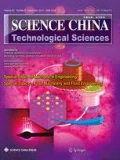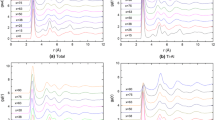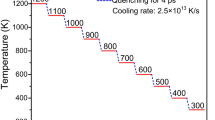Abstract
This study investigates the formation process of Ni-Nb-Al metallic glasses. To this end, a long-range n-body potential was constructed for the Ni-Nb-Al ternary metal system, and applied to atomistic simulations. The simulations not only showed the physical origins of the amorphous phase formation, but also quantitatively predicted a hexagonal compositional region that energetically favors the glass formation. The energy difference between the solid solution and metallic glass, which generates the amorphization driving force (ADF), was suggested to indicate the glass-formation ability (GFA) of each alloy. Based on the computed ADFs, the Ni55Nb25Al20 alloy exhibited the highest GFA among the Ni-Nb-Al members, implying that the glass formed by this amorphous alloy is more thermodynamically stable than other alloys in the system. In a Voronoi tessellation analysis, the knee point of the coordination-number distribution curve corresponded to the glass-formation region of the Ni-Nb-Al system.
Similar content being viewed by others
References
Yavari A R, Lewandowski J J, Eckert J. Mechanical properties of bulk metallic glasses. MRS Bull, 2004, 32: 635–638
Trexler M M, Thadhani N N. Mechanical properties of bulk metallic glasses. Prog Mater Sci, 2010, 55: 759–839
Johnson W L. Bulk glass-forming metallic alloys: Science and technology. MRS Bull, 1999, 24: 42–56
Murty B. Influence of oxygen on the crystallization behavior of Zr65Cu27.5Al7.5 and Zr66.7Cu33.3 metallic glasses. Acta Mater, 2000, 48: 3985–3996
Qin C L, Zhang W, Asami K, et al. Glass formation, corrosion behavior and mechanical properties of bulk glassy Cu-Hf-Ti-Nb alloys. Acta Mater, 2005, 53: 3903–3911
Zeng Q, Sheng H, Ding Y, et al. Long-range topological order in metallic glass. Science, 2011, 332: 1404–1406
Tian L, Cheng Y Q, Shan Z W, et al. Approaching the ideal elastic limit of metallic glasses. Nat Commun, 2012, 3: 609
Han F F, Inoue A, Han Y, et al. Novel heating-induced reversion during crystallization of Al-based glassy alloys. Sci Rep, 2017, 7: 46113
Inoue A. Amorphous, nanoquasicrystalline and nanocrystalline alloys in Al-based systems. Prog Mater Sci, 1998, 43: 365–520
Louzguine D V, Inoue A. Crystallization behaviour of Al-based metallic glasses below and above the glass-transition temperature. J Non-Cryst Solids, 2002, 311: 281–293
Janik-Czachor M, Kudelski A, Dolata M, et al. Modification of surface activity of Cu-Zr amorphous alloys and Cu metal by electrochemical methods. Mater Sci Eng-A, 1999, 267: 227–234
Yang G W, Lin C, Liu J B, et al. Formation of metastable crystalline phases by solid state reaction in Ni-Nb multilayered films. J Phys DAppl Phys, 1999, 32: 79–83
Kung K T Y, Liu B X, Nicolet M A. Study of Ni-Nb system by Ion mixing. Phys Stat Sol, 2010, 77: 355–359
Jiang Q K, Liu P, Ma Y, et al. Super elastic strain limit in metallic glass films. Sci Rep, 2012, 2: 852
Wang W H, Dong C, Shek C H. Bulk metallic glasses. Mater Sci Eng R, 2004, 44: 45–89
Lu Z P, Bei H, Liu C T. Recent progress in quantifying glass-forming ability of bulk metallic glasses. Intermetallics, 2007, 15: 618–624
Turnbull D. Under what conditions can a glass be formed? Contemp Phys, 1969, 10: 473–488
Egami T, Waseda Y. Atomic size effect on the formability of metallic glasses. J Non-Cryst Solids, 1984, 64: 113–134
Lu Z P, Liu C T. A new glass-forming ability criterion for bulk metallic glasses. Acta Mater, 2002, 50: 3501–3512
Lu Z P, Liu C T. Glass formation criterion for various glass-forming systems. Phys Rev Lett, 2003, 91: 115505
Li J H, Dai X D, Liang S H, et al. Interatomic potentials of the binary transition metal systems and some applications in materials physics. Phys Rep, 2008, 455: 1–134
Liu B X, Li J H, Lai W S. Metallic glass-forming composition range of the Cu-Zr-Ti ternary system determined by molecular dynamics simulations with many-body potentials. J Mater Res, 2011, 26: 547–560
Li J H, Dai Y, Cui Y Y, et al. Atomistic theory for predicting the binary metallic glass formation. Mater Sci Eng-R-Rep, 2011, 72: 1–28
Zhang K, Wang M, Papanikolaou S, et al. Quantum mechanical/molecular mechanical/continuum style solvation model: Time-dependent density functional theory. J Chem Phys, 2013, 139: 084106
Li J H, Dai Y, Dai X D. Long-range n-body potential and applied to atomistic modeling the formation of ternary metallic glasses. Intermetallics, 2012, 31: 292–320
Massalski T B, Hassen P, Jaffee R I. Amorphous metals and semiconductors: Proceeding of an international workshop. Coronado: Pergamon Press, 1986
Yang B, Yong D U, Liu Y. Recent progress in criterions for glass forming ability. Trans Nonferrous Met Soc China, 2009, 19: 78–84
Dai X D, Kong Y, Li J H. Long-range empirical potential model: Application to fcc transition metals and alloys. Phys Rev B, 2007, 75: 104101
Dai X D, Li J H, Kong Y. Long-range empirical potential for the bcc structured transition metals. Phys Rev B, 2007, 75: 052102
Dai Y, Li J H, Liu B X. Long-range empirical potential model: Extension to hexagonal close-packed metals. J Phys-Condens Matter, 2009, 21: 385402
Li J H, Dai Y, Dai X D, et al. Development of n-body potentials for hcp-bcc and fcc-bcc binary transition metal systems. Comput Mater Sci, 2008, 43: 1207–1215
Li Y, Li J H, Liu J B, et al. Atomic approach to the optimized compositions of Ni-Nb-Ti glassy alloys with large glass-forming ability. RSC Adv, 2014, 5: 3054–3062
Segall M D, Lindan P J D, Probert M J, et al. First-principles simulation: Ideas, illustrations and the CASTEP code. J Phys-Condens Matter, 2002, 14: 2717–2744
Clark S J, Segall M D, Pickard C J. First principles methods using CASTEP. Zeitschrift für Kristallographie, 2005, 220: 567–570
Perdew J P, Wang Y. Accurate and simple analytic representation of the electron-gas correlation energy. Phys Rev B, 1992, 45: 13244–13249
Kittel C, McEuen P. Introduction to Solid-State Physics. New York: Wiley, 1996
Simmons G, Wang H. Single Crystal Elastic Constants and Calculated Aggregate Properties: A Handbook. 2nd ed. Cambridge: MIT, 1971
Haynes W M, Lide D R, Bruno T J. CRC Handbook of Chemistry and Physics. Boca Raton: CRC Press, 2014
Villars P. Pearson’s handbook desk edition: Crystallo-graphic data for intermetallic phases. ASM International, Materials Park, 1997
Dai Y, Li J H, Che X L, et al. Proposed long-range empirical potential to study the metallic glasses in the Ni-Nb-Ta System. J Phys Chem B, 2009, 113: 7282–7290
Zhang Z J, Huang X Y, Zhang Z X. Hexagonal metastable phase formation in Ni3RM (RM=Mo, Nb, Ta) multilayered films by solidstate reaction. Acta Mater, 1998, 46: 4189–4194
Papadimitriou I, Utton C, Tsakiropoulos P. Ab initio investigation of the Nb-Al system. Comput Mater Sci, 2015, 107: 116–121
Rose J H, Smith J R, Ferrante J. Universal features of bonding in metals. Phys Rev B, 1983, 28: 1835–1845
Sheng H W, Wilde G, Ma E. The competing crystalline and amorphous solid solutions in the Ag-Cu system. Acta Mater, 2002, 50: 475–488
Panagiotopoulos A Z, Quirke N, Stapleton M, et al. Phase equilibria by simulation in the Gibbs ensemble. Mol Phys, 1988, 63: 527–545
Allen M P, Tildesley D J. Computer Simulation of Liquids. London: Oxford University Press, 1987
Parrinello M, Rahman A. Polymorphic transitions in single crystals: A new molecular dynamics method. J Appl Phys, 1981, 52: 7182–7190
Dai Y, Li J H, Che X L, et al. Glass-forming region of the Ni-Nb-Ta ternary metal system determined directly from n-body potential through molecular dynamics simulations. J Mater Res, 2009, 24: 1815–1819
Cheng Y Q, Ma E. Atomic-level structure and structure-property relationship in metallic glasses. Prog Mater Sci, 2011, 56: 379–473
Hung L S, Gyulai J, Nastasi M, et al. Ion-induced amorphous and crystalline phase formation in Al/Ni, Al/Pd, and Al/Pt thin films. Appl Phys Lett, 1983, 42: 672–674
Liu B X, Johnson W L, Nicolet M A. Nuclear Instruments & Methods in Physics Research, 1983, 209: 229–234
Yoo D J, Hwang S M, Lee S M. Phase formation in mechanically alloyed Nb-Al powders. Appl Phys Lett, 1988, 53: 1399–1401
Zhang Z J, Bai H Y, Qiu Q L, et al. Phase evolution upon ion mixing and solid-state reaction and thermodynamic interpretation in the Ni-Nb system. J Appl Phys, 1993, 73: 1702–1710
Leonhardt M, Löser W, Lindenkreuz H G. Solidification kinetics and phase formation of undercooled eutectic Ni-Nb melts. Acta Mater, 1999, 47: 2961–2968
Zhu Z, Zhang H, Pan D, et al. Fabrication of binary Ni-Nb bulk metallic glass with high strength and compressive plasticity. Adv Eng Mater, 2006, 8: 953–957
Skakov Y A, Djakonova N P, Edneral N V, et al. Some peculiarities of the atomic structure of metallic phases formed during liquid quenching and solid state reactions. Mater Sci Eng-A, 1991, 133: 560–564
Lee M, Bae D, Inoue A, et al. Classification of bulk metallic glasses by atomic size difference, heat of mixing and period of constituent elements and its application to characterization of the main alloying element. Mater Trans, 2005, 46: 2817–2829
Xia L, Li W H, Fang S S, et al. Binary Ni-Nb bulk metallic glasses. J Appl Phys, 2006, 99: 026103
Lee M H, Kim W T, Kim D H, et al. The effect of Al addition on the thermal properties and crystallization behavior of Ni60Nb40 metallic glass. Mater Sci Eng-A, 2004, 375–377: 336–340
Petzoldt F. Synthesis and process characterization of mechanically alloyed amorphous Ni-Nb powders. J Less Common Met, 1988, 140: 85–92
Tiainen T J, Schwarz R B. Synthesis and characterization of mechanically alloyed Ni-Sn powders. J Less Common Met, 1988, 140: 99–112
Kosloske A M, Jewell P F, Florman A L, et al. Acute abdominal emergencies associated with cytomegalovirus infection in the young infant. Pediatr Surg Int, 1988, 3: 43–46
Author information
Authors and Affiliations
Corresponding author
Rights and permissions
About this article
Cite this article
Cai, B., Yang, M., Liu, J. et al. Atomistic simulation study of favored compositions of Ni-Nb-Al metallic glasses. Sci. China Technol. Sci. 61, 1829–1838 (2018). https://doi.org/10.1007/s11431-018-9342-3
Received:
Accepted:
Published:
Issue Date:
DOI: https://doi.org/10.1007/s11431-018-9342-3




